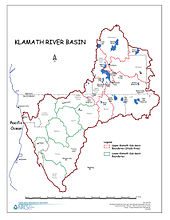- Copper Creek (California)
-
For other rivers with the same name, see Copper Creek.
Copper Creek (Chwuloq'e) Copper River River Country United States State California Regions Trinity County, Humboldt County District Six Rivers National Forest Part of Klamath River Tributaries - left Little Fork Copper Creek, Basin Creek - right Indian Creek, Alwood Creek City Orleans (closest city) Primary source West Fork Copper Creek - location Johnson Spring - elevation 5,992 ft (1,826 m) Secondary source East Fork Copper Creek - location West Redina Peak - elevation 5,416 ft (1,651 m) Source confluence - elevation 2,350 ft (716 m) - coordinates 40°59′04″N 123°34′56″W / 40.98444°N 123.58222°W Mouth Klamath River - location Near Orleans - elevation 398 ft (121 m) - coordinates 41°35′26″N 123°31′20″W / 41.59056°N 123.52222°W Length 14 mi (23 km), South-North Basin 118 sq mi (306 km2) Discharge - average 305 cu ft/s (9 m3/s) - max 12,600 cu ft/s (357 m3/s) - min 16.2 cu ft/s (0 m3/s) Copper Creek (also called the Copper River, natively called Chwuloq'e, for chinook salmon) is a southern tributary of the Klamath River in the U.S. state of California. Arising in the Klamath Mountains, the creek drains a narrow watershed of about 120 square miles (310 km2). Historically, Copper Creek was the site of at least one Hupa Native American village, then was extensively mined for gold in the 1850s. The origin of the name comes from the peach-colored cliffs that line the lower few miles of the canyon.
Contents
Course
It rises as two forks in the Six Rivers National Forest in Trinity County; the West Fork is the larger of the two branches. The West Fork begins at Johnson Spring on the northeastern flank of an unnamed ridge at an elevation of 5,992 feet (1,826 m).[1] From there, it flows north about 16.5 miles (26.6 km) to its confluence with the East Fork at 40°37′49″N 123°20′48″W / 40.6304°N 123.3466°W.[2] The East Fork rises on the south flank of West Redina Peak at 5,416 feet (1,651 m)[3] and flows northwest for 14.2 miles (22.9 km) to the confluence.
From the confluence, Copper Creek proceeds to flow north-northwest, looping to the southeast at the confluence with Basin Creek. It then turns north again, meandering through a relatively straight valley, and receives in quick succession Graham Creek and Lost Cow Creek from the right. At the confluence with Indian Creek, the creek swings northwest, crossing the Humboldt County line and looping along the east flank of Salmon Mountain. From there, the river proceeds north-northwest through a canyon flanked by the copper-colored cliffs that were responsible for the origin of its name—before receiving Little Copper Creek from the left and emptying into the Klamath River 3 miles (4.8 km) downstream of the city of Orleans. The Klamath flows a further 40 miles (64 km) to empty into the Pacific Ocean.[4][5]
History
Historically, the Hupa tribe lived along Copper Creek and the Klamath River around the area of the Copper's mouth. The river was called Chwuloq'e, meaning chinook salmon. One Hupa village was located on the creek, within 5 miles (8.0 km) of the mouth. The river received its modern name in 1851 when miners attracted by the California Gold Rush discovered the river while traveling on the Klamath in search of gold. The copper-colored cliffs that line the last few miles of the creek's canyon inspired them to give the stream its present name.[6] The miners eventually employed hydraulic mining in order to find deeper deposits of gold in the hillsides surrounding the river. This practice severely hurt the ecology of the creek and its salmon run.[7]
See also
Works cited
- Durham, David L. (1998). California's geographic names: a gazetteer of historic and modern names of the state. Quill Driver Books. ISBN 1-88499-514-4.
- Gudde, William (2004). California Place Names: The Origin and Etymology of Current Geographical Names. University of California Press. ISBN 0-52024-217-3.
- Palmer, Tim (1993). The wild and scenic rivers of America. Island Press. ISBN 1-55963-145-7.
References
- ^ "West Fork Copper Creek". Geographic Names Information System, U.S. Geological Survey. 1981-01-19. http://geonames.usgs.gov/pls/gnispublic/f?p=gnispq:3:::NO::P3_FID:2124509. Retrieved 2010-01-13.
- ^ "Copper Creek". Geographic Names Information System, U.S. Geological Survey. 1981-01-19. http://geonames.usgs.gov/pls/gnispublic/f?p=gnispq:3:::NO::P3_FID:2124304. Retrieved 2010-01-13.
- ^ "East Fork Copper Creek". Geographic Names Information System, U.S. Geological Survey. 1981-01-19. http://geonames.usgs.gov/pls/gnispublic/f?p=gnispq:3:::NO::P3_FID:2124505. Retrieved 2010-01-13.
- ^ ACME Mapper. USGS Topo Maps for United States (Map). Cartography by United States Geological Survey. http://mapper.acme.com/. Retrieved 2010-01-13.
- ^ Durham, p. 469
- ^ Gudde and Bright, p. 90
- ^ Palmer, p. 133-134
Klamath River States and counties 
Significant cities Major tributaries Williamson River · Sprague River · Lost River · Butte Creek · Shasta River · Scott River · Salmon River · Trinity RiverGeography History Dams and infrastructure Link River Dam · Keno Dam · J.C. Boyle Dam · Copco Dam #1 · Copco Dam #2 · Iron Gate Dam · California State Route 96 · California State Route 169Categories:- Tributaries of the Klamath River
- Rivers of Humboldt County, California
- Rivers of Trinity County, California
Wikimedia Foundation. 2010.
